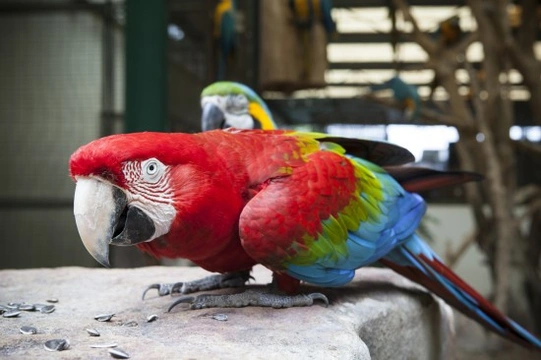
Red and Green Macaw Care Guide: Green-Winged Macaw UK 2025
The Red and Green Macaw (Ara chloropterus), also known as the Green-winged Macaw, is one of the largest and most striking species in the Ara family. Native to South America, these birds are celebrated for their vivid red plumage, distinctive green band on the wings, and blue flight feathers and tail tips. The face features white skin lined with tiny red feathers, reflecting their unique beauty and character.
Physically, they measure approximately 90-95cm (35 inches) in length, weigh between 1050 and 1700 grams (2.3 to 3.7lbs), and boast a wingspan up to 122.5cm (49 inches). Their strong, large beak is pale yellow above and black below, specially adapted to crack tough nuts. Despite their formidable size, these birds are known as gentle giants with affectionate behaviours when hand-reared properly.
Keeping Red and Green Macaws
When considering a Green-winged Macaw for sale, it is best to choose a partly hand-reared bird. Raised in close contact with humans from a young age, they thrive as devoted family members and respond well to patient training. Macaws are social creatures typically found in groups of 6-8 in the wild, and this social nature influences their captive care requirements.
For breeders, pairing an established bonded pair is ideal, though young birds can be kept in small groups to allow natural mate selection. It is important to house such large birds in spacious aviaries or rooms to prevent wing and tail damage. Their strength means aviary materials must be very robust, avoiding wood framework which they can easily shred. Providing safe, chewable plants and climbing structures like thick branches enriches their environment and promotes natural behaviours.
Noise can be significant as macaws shriek loudly, which should be considered if living in urban areas. Individually, they can learn to mimic human sounds to some extent, adding to their charm as companions. They enjoy bathing and benefit from mist-spraying on warm days.
Feeding Macaws
Specialised macaw pellets form the staple diet, complemented by about 30% fresh fruit and vegetables. Suitable fruits include grapes, oranges, melons, bananas, and peeled apples or plums; vegetables like broccoli, spinach, kale, carrots, peas, and sweetcorn are well accepted. It is crucial to avoid avocado which is toxic to all birds.
Human foods such as cooled pasta and wholegrain bread can be offered sparingly, alongside cereals and grains that provide protein and carbohydrates. Digestive aids like grit, cuttlebone, and charcoal blocks are important for beak and digestive health, replicating mineral sources found in the wild clay licks they frequent. Fresh willow twigs also help maintain beak and claw condition.
Breeding Red and Green Macaws
Breeding these macaws is challenging and requires a harmonious pair. Birds reach sexual maturity at four years old, and breeding success improves with established pairs. Outdoor aviaries with ample space and large nest boxes mimic natural tree hollow nesting sites. The female lays 2-4 eggs, incubating them for 24-28 days. Fledging occurs at 3-4 months with parental feeding continuing beyond this.
Conclusion
Owning or breeding Red and Green Macaws is a long-term commitment requiring dedication, space, and specialised knowledge. These large, affectionate birds can be treasured family members for up to 80 years with proper care. If you have the time, resources, and passion, the Green-winged Macaw is a remarkable companion offering intelligence, beauty, and a lifetime of companionship.



